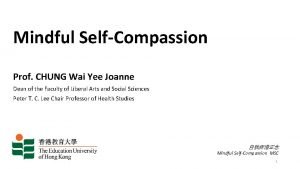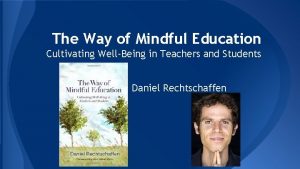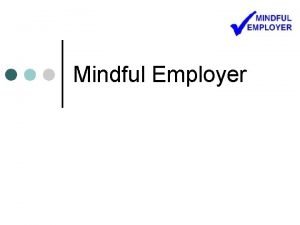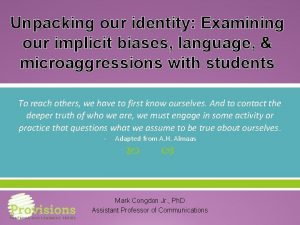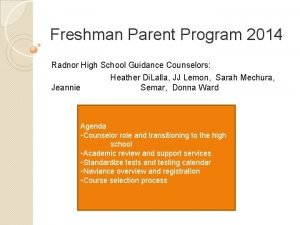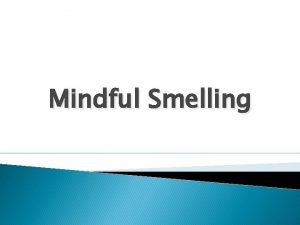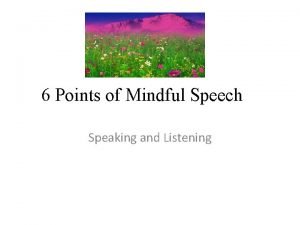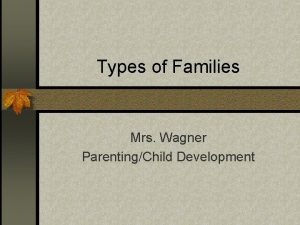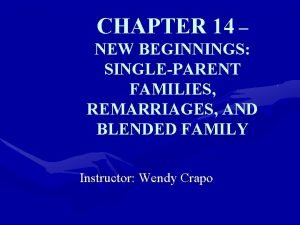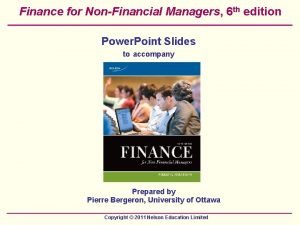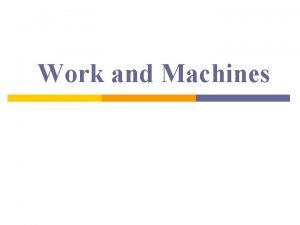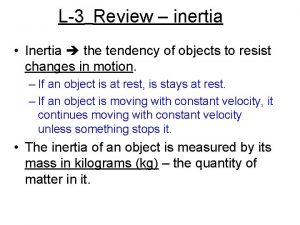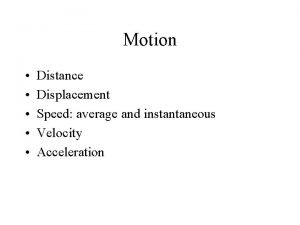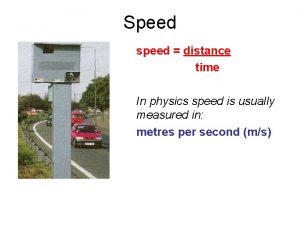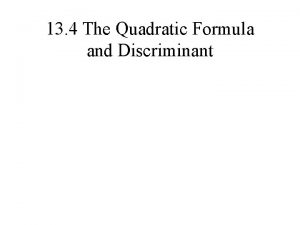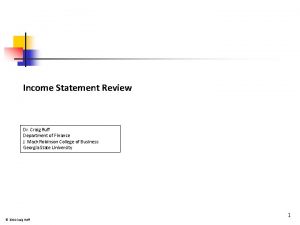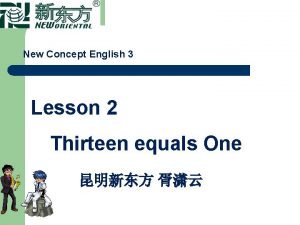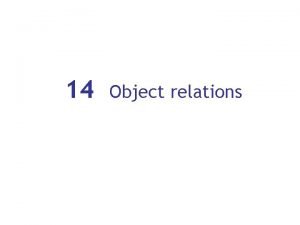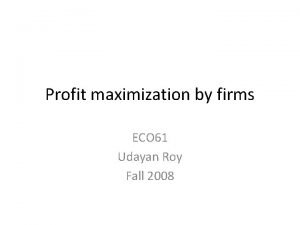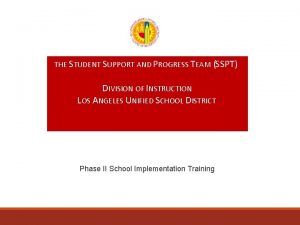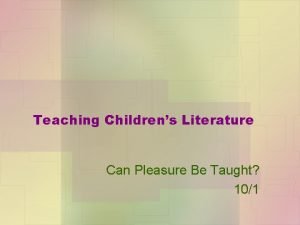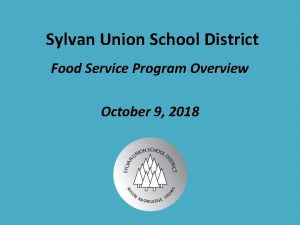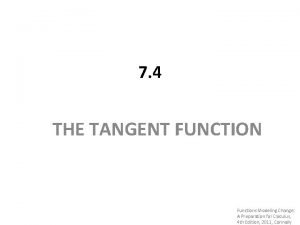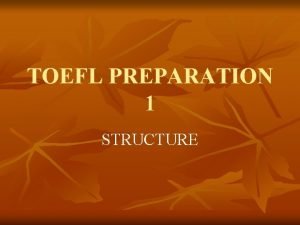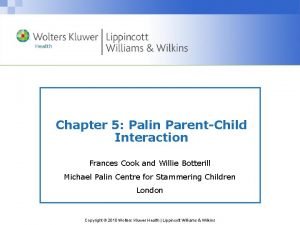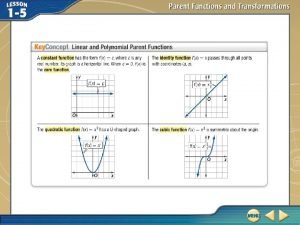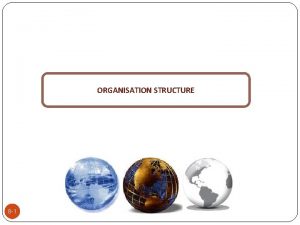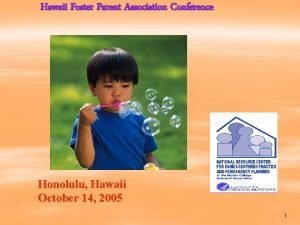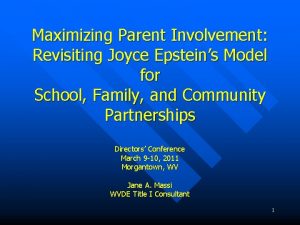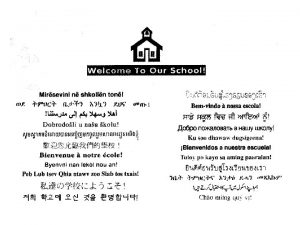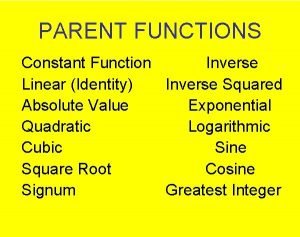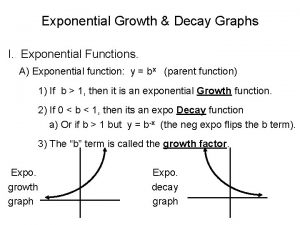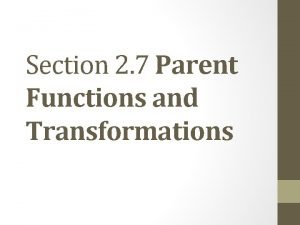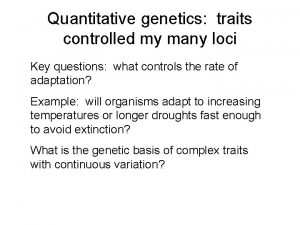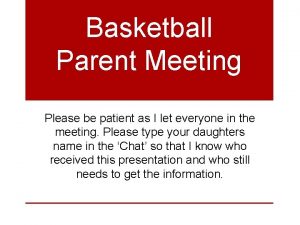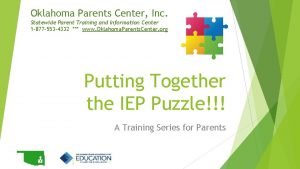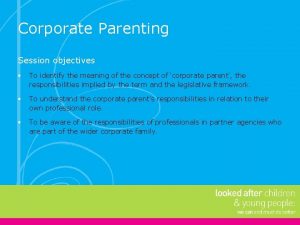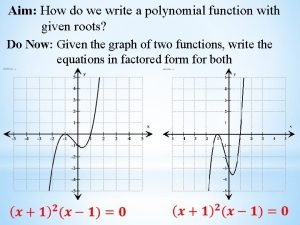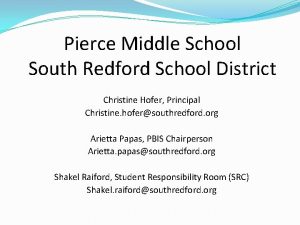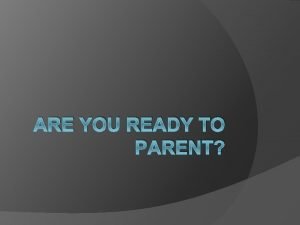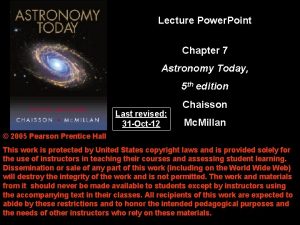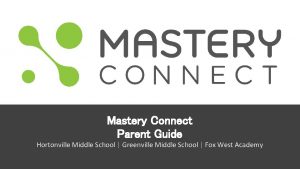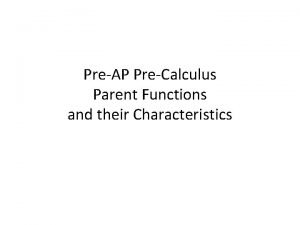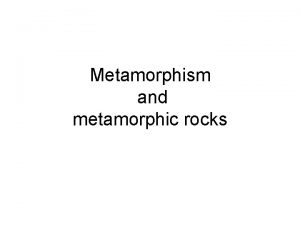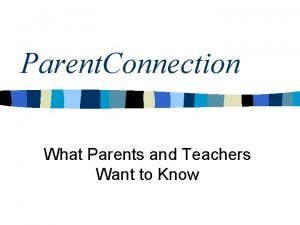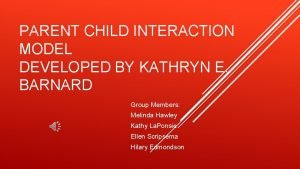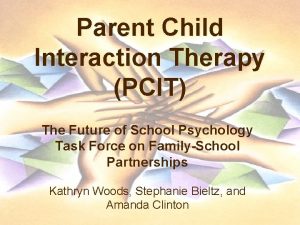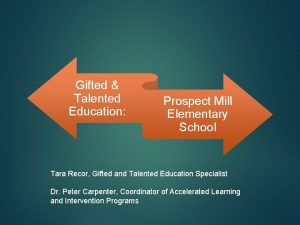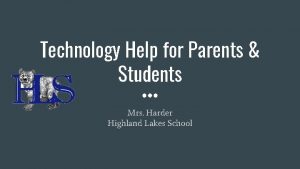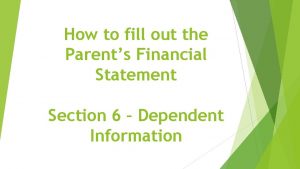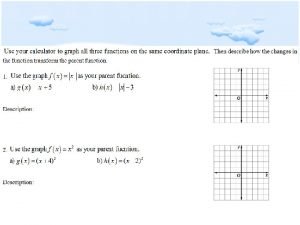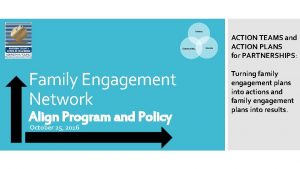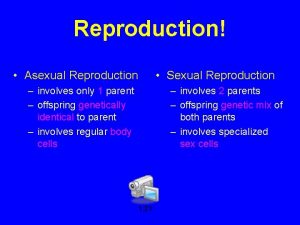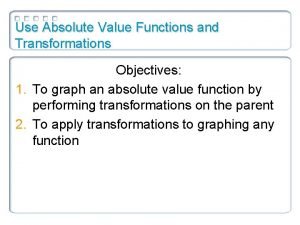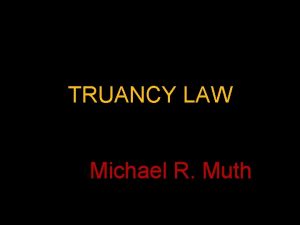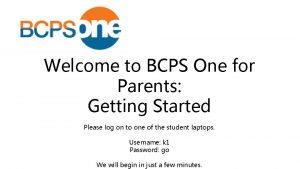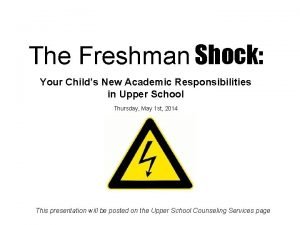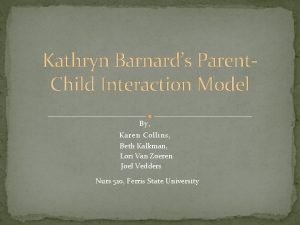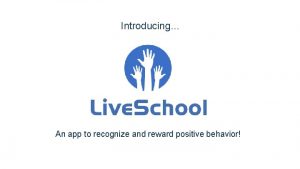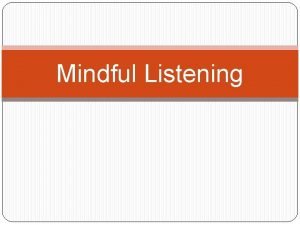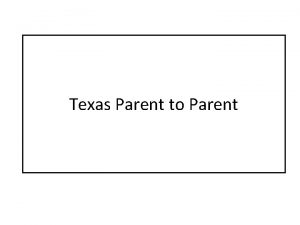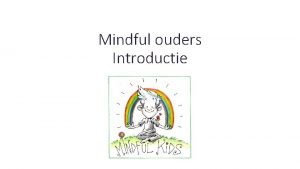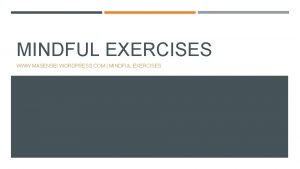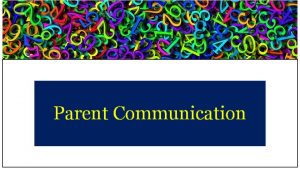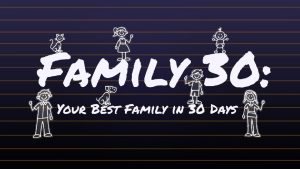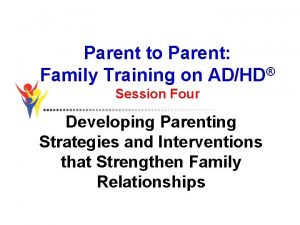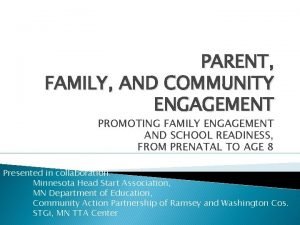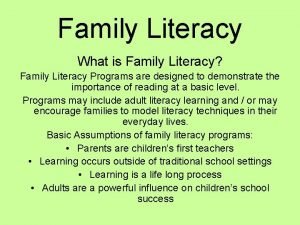A Mindful Parent Equals a Mindful Family in



































































































































































- Slides: 163

A Mindful Parent Equals a Mindful Family in Play Therapy “To parent perfectly is a mirage. There is no ideal parent and no ideal child. ” Shefali Tsabary, Ph. D. Author of The Conscious Parent

What is Mindful Parenting? Julie R. Plunkett LPC, LCPC, RPT-S

Mindful Parenting ▪ Kabat Zinn (2003, as cited in Duncan, Coatsworth, & Greenberg, 2009) defines mindfulness as: ‘‘the awareness that emerges through paying attention, on purpose, in the present moment, and nonjudgmentally to the unfolding of experience moment by moment. ” (p. 1) ▪ A framework that helps parents intentionally become aware of moment to moment interactions with their child. ▪ The skills of listening with full attention to their child ▪ The skill of increasing emotional awareness and self-regulation in parenting ▪ The skill of bringing compassion and nonjudgmental acceptance Duncan, L. G. , Coatsworth, J. D. , & Greenberg, M. T. (2009). A Model of Mindful Parenting: Implications for Parent–Child Relationships and Prevention Research. Clinical Child and Family Psychology Review, 12(3), 255 -270. doi: 10. 1007/s 10567 -009 -0046 -3

Dimensions of Mindful Parenting Duncan, et al. (2009) cite five dimensions of parenting: 1. Listening with full attention 2. Accepting oneself and one’s child nonjudgmentally. 3. Being emotionally aware of oneself and one’s child 4. Being able to self-regulate as a parent 5. Compassion for oneself and one’s child Duncan, L. G. , Coatsworth, J. D. , & Greenberg, M. T. (2009). A Model of Mindful Parenting: Implications for Parent–Child Relationships and Prevention Research. Clinical Child and Family Psychology Review, 12(3), 255 -270. doi: 10. 1007/s 10567 -009 -0046 -3

Core Qualities of Mindfulness Shapiro et al. (2006 as cited in Duncan, 2009) discuss three core qualities of mindfulness that occur in the moment-to-moment experiences of mindfulness: 1. Present focused attention and awareness 2. Being intentional or purposeful to your own attention and behavior 3. An attitude of paying attention; interest, curiosity, nonjudgment, acceptance, compassion and receptiveness Duncan, L. G. , Coatsworth, J. D. , & Greenberg, M. T. (2009). A Model of Mindful Parenting: Implications for Parent–Child Relationships and Prevention Research. Clinical Child and Family Psychology Review, 12(3), 255 -270. doi: 10. 1007/s 10567 -009 -0046 -3

Learning to be Mindful Learning to be aware of and pay close attention to the inner states: ▪ Thoughts ▪ Emotions ▪ Physical sensations ▪ Awareness of the outside world ▪ Curious interest rather than premature judgement Weare, K. (2013). Developing mindfulness with children and young people: a review of the evidence and policy context. Journal of Children's Services, 8(2), 141 -153. doi: 10. 1108/jcs-12 -20120014

Mindful Practices in Parenting ▪ Builds a family environment that increases and sustains satisfaction and enjoyment in the parent-child relationship. ▪ Increases a higher quality relationship with their child. ▪ Decreases the chances of avoiding automatic maladaptive parenting behaviors ▪ Cultivates open and trusting family relationships ▪ Promotes healthy psychosocial development of their child. Duncan, L. G. , Coatsworth, J. D. , & Greenberg, M. T. (2009). A Model of Mindful Parenting: Implications for Parent–Child Relationships and Prevention Research. Clinical Child and Family Psychology Review, 12(3), 255 -270. doi: 10. 1007/s 10567 -009 -0046 -3

Benefits of Mindful Parenting

Benefits of Mindfulness ▪ Self-reported positive affect ▪ Decrease in anxiety ▪ Decrease in depression ▪ Increased relationship satisfaction ▪ Less relationship stress ▪ Increase in brain activity linked to emotion ▪ Increased secure parent-child relationships Duncan, L. G. , Coatsworth, J. D. , & Greenberg, M. T. (2009). A Model of Mindful Parenting: Implications for Parent–Child Relationships and Prevention Research. Clinical Child and Family Psychology Review, 12(3), 255 -270. doi: 10. 1007/s 10567 -009 -0046 -3

Mindful Parenting Table 1 Role of mindful parenting practices in parenting interactions (p. Mindful parenting dimensions Effective parenting behaviors promoted through this practice Parenting behaviors decreased through this practice Listening with full attention • Correctly discern child’s behavioral cues • Accurately perceive child’s verbal communication • Reduced use and influence of cognitive constructions and expectations Nonjudgmental acceptance of self and child • Healthy balance between child-oriented, parentoriented, and relationship-oriented goals • Sense of parenting self-efficacy • Appreciation for child’s traits • Reduction in self-directed concerns • Fewer unrealistic expectations of child’s attributes Duncan, L. G. , Coatsworth, J. D. , & Greenberg, M. T. (2009). A Model of Mindful Parenting: Implications for Parent–Child Relationships and Prevention Research. Clinical Child and Family Psychology Review, 12(3), 255 -270. doi: 10. 1007/s 10567 -009 -0046 -3

Mindful Parenting Table 1 Role of mindful parenting practices in parenting interactions (p. Mindful parenting dimensions Effective parenting behaviors promoted through this practice Parenting behaviors decreased through this practice Emotional awareness of self and child • Responsiveness to child’s needs and emotions • Greater accuracy in responsibility attributions • Less dismissing of child’s emotions • Less discipline that results from parent’s strong negative emotion (e. g. , anger, disappointment, shame) Self-regulation in the parenting relationship • Emotion regulation in the parenting context • Parenting in accordance with goals and values • Less overreactive/‘‘automatic’’ discipline • Less dependence on child’s emotions Duncan, L. G. , Coatsworth, J. D. , & Greenberg, M. T. (2009). A Model of Mindful Parenting: Implications for Parent–Child Relationships and Prevention Research. Clinical Child and Family Psychology Review, 12(3), 255 -270. doi: 10. 1007/s 10567 -009 -0046 -3

Mindful Parenting Table 1 Role of mindful parenting practices in parenting interactions (p. Mindful parenting dimensions Effective parenting behaviors promoted through this practice Parenting behaviors decreased through this practice Compassion for self and child • Positive affection in the parent–child relationship • More forgiving view of own parenting efforts • Less negative affect displayed in the parent–child relationship • Less self-blame when parenting goals are not achieved Duncan, L. G. , Coatsworth, J. D. , & Greenberg, M. T. (2009). A Model of Mindful Parenting: Implications for Parent–Child Relationships and Prevention Research. Clinical Child and Family Psychology Review, 12(3), 255 -270. doi: 10. 1007/s 10567 -009 -0046 -3

Reparative Qualities of Mindful Parenting ▪ Disrupt parent/child and intergenerational cycles of negativity ▪ Disrupt parent/child and intergenerational cycles of disengagement ▪ Disruption of automatic negative interactions ▪ Create resilience in times of stress and coping for parent and child Duncan, L. G. , Coatsworth, J. D. , & Greenberg, M. T. (2009). A Model of Mindful Parenting: Implications for Parent–Child Relationships and Prevention Research. Clinical Child and Family Psychology Review, 12(3), 255 -270. doi: 10. 1007/s 10567 -009 -0046 -3

A Mindful Family Julie R. Plunkett LPC, LCPC, RPT-S

A Household Built on Being ▪ Adult self-esteem is based on doing: ▪ ▪ How much we do How much we learn How good we look to others How socially connected we are ▪ Child self-esteem is based on being. ▪ Live in the moment ▪ Celebrate their existence ▪ Children must be taught to “do”. ▪ To parent mindfully is to parent different than society demands. Tsabary, S. (2010). The conscious parent: transforming ourselves, empowering our children. Vancouver: Namaste Pub.

A Household Built on Being ▪ Early Years Child Focus (to help child learn about themselves)▪ ▪ ▪ Play dates Lazy hours Self directed play Imagination State of being ▪ Early Years Parent Focus ▪ ▪ Structured activities Hectic schedules Always on the move State of doing Tsabary, S. (2010). The conscious parent: transforming ourselves, empowering our children. Vancouver: Namaste Pub.

A Household Built on Being ▪ Why the doing? ▪ ▪ ▪ Life cannot exist as it is To overcompensate for our own feelings of incompetence Sense of self is based on “doing” for our child We (often unconsciously) try to live through our children “If her children fail to contort themselves to her requirements, she can’t tolerate it, which leads to an even more unhealthy dynamic of manipulating her children to get them to be “good”. ” (p. 142). ▪ Consequences of Doing- “The lesson is that if we teach our children to predicate their sense of identity on “doing”, they will be unhappy every time life fails them in some way. ” (p. 142) Tsabary, S. (2010). The conscious parent: transforming ourselves, empowering our children. Vancouver: Namaste Pub.

Anxiety as a Form of “Doing” Parent’s Focus Child’s Lesson Difficulties are to be feared, not celebrated as signs of resilience. “Poor me. Feelings of victimhood and role of the martyr All that is lacking in the present moment World is viewed through lack. ▪ Anxiety causes parents to focus on what is familiar because they feel emptiness ▪ To focus on the familiar is to focus on what is missing ▪ A focus on what is lacking in life leads to an inability to see abundance in life. Tsabary, S. (2010). The conscious parent: transforming ourselves, empowering our children. Vancouver: Namaste Pub.

Anxiety as a Form of “Doing” ▪ Anxiety creates a need to control. ▪ Parents lose their authenticity ▪ With lack of authenticity there is a need for parents to control themselves by controlling others, especially our children ▪ Parents try to control what happens in their life by controlling the outcomes of situations ▪ Parents try to control by organizing their family members ▪ Worrying allows parents to feel reassured that they are “doing” something to control their life and things around them. Tsabary, S. (2010). The conscious parent: transforming ourselves, empowering our children. Vancouver: Namaste Pub.

Anxiety as a Form of “Doing” ▪ Worrying covers the fear of being “present” in the moment. ▪ Paradox of control: Parent is actually out of control. They are unable to change things for the better. ▪ This becomes an intergenerational cycle and is broken when parents discover that worrying is a cover for the fear of being present. ▪ Parents becoming present allows their children to trust in life as good. Tsabary, S. (2010). The conscious parent: transforming ourselves, empowering our children. Vancouver: Namaste Pub.

Source of the Fear of being “Present” ▪ Parents are afraid to experience solitude. ▪ In order not to feel solitude parents will fill their day with doing things, including structuring their children’s lives. ▪ The ultimate fear though is the fear of death. ▪ Our culture has a fear of acknowledging the inevitableness or our death so we live as though death does not affect us. We live in denial. ▪ Coming to terms with morality helps decrease the clutter noise and drama of a life of doing. Tsabary, S. (2010). The conscious parent: transforming ourselves, empowering our children. Vancouver: Namaste Pub.

Empowerment ▪ Accepting that our existence is lived moment by moment and is tenuous ▪ Becoming connected to the wonder of the everyday ▪ Cherishing every moment of our children’s life, especially the ordinary ▪ Focus our time and energy on connections with others in our life instead of material existence. ▪ Sit with how life is instead of creating drama ▪ Spending time on activities that bring joy Tsabary, S. (2010). The conscious parent: transforming ourselves, empowering our children. Vancouver: Namaste Pub.

Following our Children’s Example ▪ Our children understand authenticity at an instinctual level how to just “be” ▪ Our children live within their body and respond to their spirit ▪ Our children are aware of living in the present ▪ Our children can teach us how to really live. Tsabary, S. (2010). The conscious parent: transforming ourselves, empowering our children. Vancouver: Namaste Pub.

Mindful Child Weare, K. (2013) found that by using mindfulness children report: ▪ Increase in emotional intelligence ▪ Increase in coping skills ▪ Increase in calmness and control of emotions ▪ Increased ability to make meaningful relationships ▪ Increased ability to accept experiences fully Weare, K. (2013). Developing mindfulness with children and young people: a review of the evidence and policy context. Journal of Children's Services, 8(2), 141 -153. doi: 10. 1108/jcs-12 -20120014

Mindful Child Weare, K. (2013) found that by using mindfulness children report: ▪ Increase in emotional intelligence ▪ Increase in coping skills ▪ Increase in calmness and control of emotions ▪ Increased ability to make meaningful relationships ▪ Increased ability to accept experiences fully Weare, K. (2013). Developing mindfulness with children and young people: a review of the evidence and policy context. Journal of Children's Services, 8(2), 141 -153. doi: 10. 1108/jcs-12 -20120014

The Mindful Parent ▪ Patient- No hurry to impose activity on our children ▪ Childhood is a time to plant seeds in our children, not reap the harvest. ▪ Recognize it is our children’s choice to water the seeds they want based on their own internal wisdom and sense of identity. ▪ “…trusts implicitly the child’s intuition concerning it’s destiny. ” (p. 149). ▪ This is the same idea used in Child Centered Play Therapy. Tsabary, S. (2010). The conscious parent: transforming ourselves, empowering our children. Vancouver: Namaste Pub.

The Mindful Parent ▪ Patient- No hurry to impose activity on our children ▪ Childhood is a time to plant seeds in our children, not reap the harvest. ▪ Recognize it is our children’s choice to water the seeds they want based on their own internal wisdom and sense of identity. ▪ “…trusts implicitly the child’s intuition concerning it’s destiny. ” (p. 149). ▪ This is the same idea used in Child Centered Play Therapy. Tsabary, S. (2010). The conscious parent: transforming ourselves, empowering our children. Vancouver: Namaste Pub.

What We Teach Our Children ▪ Being focused on where our children end up in life leads to our children learning “time is money” ▪ Being focused on the present teaches them time is infinite and to be experienced in the present. ▪ Being focused on doing teaches children to focus on money or image. ▪ Being focused on being teaches children to live for their own inner purpose ▪ Being focused on the ordinary moments: giving a bath, eating together, driving in the car, chores; increases emotional connection. Tsabary, S. (2010). The conscious parent: transforming ourselves, empowering our children. Vancouver: Namaste Pub.

Connecting ▪ Connecting in the moment of each day creates opportunities for interaction with our children. ▪ When your children speak to you: set aside what you are doing and give them your full connection. Look them in the eye. ▪ Start the day greeting and engaging your children before the rush of the day starts. ▪ Sing a song with them ▪ Share a joke ▪ Play a game Tsabary, S. (2010). The conscious parent: transforming ourselves, empowering our children. Vancouver: Namaste Pub.

Small Ways to Connect ▪ Touch your child when passing them in the hall ▪ Tell them how much you love them at random moments ▪ Greet them with complete acceptance ▪ Invite them to tell about their day ▪ Tell them about your day ▪ Leave them a note in their backpack that you miss them and are thinking about them. Tsabary, S. (2010). The conscious parent: transforming ourselves, empowering our children. Vancouver: Namaste Pub.

Small Ways to Connect ▪ Laugh daily with your child ▪ Treat bedtime as a sacred time where the child leads in their nightly rituals and needs ▪ Ideas to help with this: ▪ Theraplay: Helping Parents and Children Build Better Relationships Through Attachment-Based Play by Phyllis B. Booth and Ann M. Jernberg ▪ I Love You Rituals by Becky Bailey Tsabary, S. (2010). The conscious parent: transforming ourselves, empowering our children. Vancouver: Namaste Pub.

The Secret of a Mindful Life ▪ An infant or toddler can show us the secret to living a mindful life. ▪ They inhabit the present moment ▪ “Even though infants and toddlers are touted as having minimal consciousness, it is they who most embody the elements of conscious living. How? By their ability to respond to life in its as is form, without the encumbrances of egoic liabilities such as fear, guilt, attachment or a need to control. ” (p. 152) ▪ Adults are the ones who train this out of them by taking them out of the present moment and into the mind ▪ This causes them to trade being spontaneous with habit. Tsabary, S. (2010). The conscious parent: transforming ourselves, empowering our children. Vancouver: Namaste Pub.

The Secret of a Mindful Life ▪ Living in the present helps us see the newness of each situation as a child does. ▪ “When we are blinded by our past or yearn for our future, we miss the opportunities that are evident to the eye of wisdom but invisible to the overcrowded, over analytic mind. Before we know it we lose our connection to our authentic self, and therefore to each other. The authentic self only develops through awareness of the present moment. ” (p. 153) ▪ To raise a mindful child the parent must live in the present. Tsabary, S. (2010). The conscious parent: transforming ourselves, empowering our children. Vancouver: Namaste Pub.

Worldly Concerns ▪ We want our children to be successful because we seek validation through them. ▪ Children are not born to have worldly concerns. They learn early on that to be a part of a competitive world that is made up of performers and non-performers ▪ “They learn that they are measured criteria external to themselves: grades, teacher’s remarks, how they are seen by peers. Unfortunately they also learn about labels: ADD, PDD, learning disabled, bipolar—and, at the other end of the spectrum, gifted and talented. They learn that their behavior is constantly under scrutiny. Should they fall short of some socially accepted criteria, they find themselves subject to humiliation. ” (p. 155 -56) Tsabary, S. (2010). The conscious parent: transforming ourselves, empowering our children. Vancouver: Namaste Pub.

Worldly Concerns ▪ Teaching them about worldly concerns teaches them they are not good enough in the adult world. ▪ If a parent is raised with worldly concerns during childhood they will not be able to tolerate ordinariness in their child. ▪ Allow a child to explore what they are interested in, but don’t put importance on their sense of self worth being based on achievement ▪ Enjoy your children excelling, but not at the expense of enjoying their ordinariness. ▪ Learning to value the ordinary is to learn to live life itself. Tsabary, S. (2010). The conscious parent: transforming ourselves, empowering our children. Vancouver: Namaste Pub.

Over production of life ▪ Parents who do not understand their own essence compensate by making everything a big deal. ▪ When a parent has an inadequate sense of their own value they will exaggerate life ▪ The consequence for their children is they grow up learning that life has to always be busy. ▪ “They grow up addicted to a life of highs and lows, unable to rest in the ordinary and with little perspective on how to glean enjoyment from the mundane. ” (p. 158) ▪ Only when they are allowed to be themselves are they able to really enjoy life Tsabary, S. (2010). The conscious parent: transforming ourselves, empowering our children. Vancouver: Namaste Pub.

Over production of life ▪ Emotional sturdiness comes from managing emotions without external help. ▪ “Imaginative by nature, children are able to respond to the as is with body, soul and spirit. Our children only need an empty room, their imagination, and a willing partner-in-crime. They don’t’ need expensive gadgets and a room full of toys, just their creativity born of their still center. ”(p. 159) ▪ Being in touch with themselves teaches them to be happy with what they have, contentment that comes from within. Tsabary, S. (2010). The conscious parent: transforming ourselves, empowering our children. Vancouver: Namaste Pub.

Over production of life “When children are full of confidence, seeing only abundance, opportunity, expansion and adventure, they have an oceanic faith in the goodness of the universe. It’s our spiritual obligation to allow them to foster their innate capacity to engage life. It’s too early for us to burst their bubble. Let them dance and not worry about the performance at the end. Let them draw and not concern themselves with how good or bad the product is. Let them go to school and not be anxious about the grade they get, realizing that when we are overly invested in our grades or how well they do at a certain hobby, they begin to lose interest in the learning and focus only on the perfection of the outcome. Let them fly in their imagination without us telling them they are impractical for doing so. ” (p. 161) Tsabary, S. (2010). The conscious parent: transforming ourselves, empowering our children. Vancouver: Namaste Pub.

Manifestation of Creative Potential ▪ Encourage your children to listen to their inner voice ▪ Teach them to love the process of learning ▪ Help them enjoy mastering a skill ▪ Help them revel in taking a risk ▪ Teach them to laugh at themselves when they fail ▪ This teaches them to unleash themselves Tsabary, S. (2010). The conscious parent: transforming ourselves, empowering our children. Vancouver: Namaste Pub.

The urgency to “do” ▪ The inability to value free time is learned ▪ Children learn restlessness by modeling after their parents being busy all the time ▪ Children are able to adjust to changes in life easily when their parents do not interfere. ▪ Filling children with activities, toys, electronics and so on takes away their imagination and their ability to create their own pleasure. Tsabary, S. (2010). The conscious parent: transforming ourselves, empowering our children. Vancouver: Namaste Pub.

Back to basics ▪ The best way to help our children return to their natural state is to reduce their amount of screen time. ▪ Screen time used for boredom teaches children to be dependent on external aids instead of internal. ▪ Screen time replaces relationships and takes away our children’s ability to learn to sit with emotions and how to manage them. ▪ Instead of buying things for them, do things with them. Go to the zoo, the park, and so on. ▪ Children need our attention, not our money. Tsabary, S. (2010). The conscious parent: transforming ourselves, empowering our children. Vancouver: Namaste Pub.

Back to basics ▪ When parents stay calm and not panic frequently their children will develop resilience. ▪ “The reality is that children need stress to grow. Learning to tolerate the pain of seeing them deal with stress, allowing them to sit in the discomfort of their imperfections, staying out of it while they are forced to decide between two equally desirable and undesirable choices—all of this is essential for a child’s development. ” (p. 164) Tsabary, S. (2010). The conscious parent: transforming ourselves, empowering our children. Vancouver: Namaste Pub.

Back to basics ▪ “During times of stress and tension, the ability to think outside the box can so easily become constricted and wither away. This is why its crucial that you teach your child to engage in life from an authentic sense of deep calling, as opposed to fulfilling and ego desire. Once they hold within them the power to transform their hardships, they will never find themselves at a loss for sustenance because they will know that the source of everything is within them. They will make rubies out of rubble because they see this is how you live your life. ” (p. 164). Tsabary, S. (2010). The conscious parent: transforming ourselves, empowering our children. Vancouver: Namaste Pub.

Mirror who your child is ▪ Children need someone to mirror who they are in order to express their uniqueness. ▪ Parents need to ask their children for input on decisions about their life in order to allow their inner world to come to life. ▪ Parents need to present children with choices that are age appropriate and allow them to make wise decisions. ▪ Parents need to allow their children freedom to have a different viewpoint, to disagree with them. Tsabary, S. (2010). The conscious parent: transforming ourselves, empowering our children. Vancouver: Namaste Pub.

Expectations of Children ▪ Instead of trying to decide what your child should be when grown up, parents need to realize they are already who they are. ▪ Children are full of what is, not what isn’t. ▪ Parents need to be wary of teaching their children to operate from lack and incompleteness. ▪ “For our child to see a look of disappointment in our eyes sows the seeds of anxiety, self-doubt, hesitation and inauthenticity. They then begin to believe they should be more beautiful, competent, smart or talented. In this way we strip them of their enthusiasm for expressing themselves as they are right now. ” (p. 168) Tsabary, S. (2010). The conscious parent: transforming ourselves, empowering our children. Vancouver: Namaste Pub.

Expectations of Children ▪ Celebrate their ability to be true to themselves ▪ ▪ ▪ ▪ Build trust Inspire them to follow their insight Faith in you being there when they fall They are their own safety net Experience life to experience life Courage resilience Tsabary, S. (2010). The conscious parent: transforming ourselves, empowering our children. Vancouver: Namaste Pub.

Honor your child ▪ Honor your own life so you can honor your child’s life ▪ Children need space to explore their natural interests and practice expressing them. ▪ A parents task is to respond in delight through their eyes and smile that their child is the most important when they are just being ▪ High expectations too early stop a child from reaching their potential Tsabary, S. (2010). The conscious parent: transforming ourselves, empowering our children. Vancouver: Namaste Pub.

Honor your child ▪ Accept children where they are ▪ Parents need to not use their child to heal their own damaged parts. ▪ Parents need to have their own life aside from their child's life. ▪ A parent who is content with being does not need their child to earn awards. Tsabary, S. (2010). The conscious parent: transforming ourselves, empowering our children. Vancouver: Namaste Pub.

Honor your child ▪ Children have the potential to manifest a reality for themselves we can not even begin to imagine. ▪ Setting the bar: ▪ In a way that mirrors who they already are ▪ Teaching them to trust their belief in their own value and competence ▪ They will want to live up to excellence ▪ Expectations of your children ▪ Respect for themselves ▪ Respect for others ▪ Their own safety Tsabary, S. (2010). The conscious parent: transforming ourselves, empowering our children. Vancouver: Namaste Pub.

Hopes for our children (p. 173) ▪ Not that they be a good achiever, but a good learner ▪ Not that they will obey you, but respect you ▪ Not that they will blindly follow your dictates, but that they will seek your counsel ▪ Not that they will be a star, but they will master the art of being ▪ Not that they will follow your vision, but that they will create their own ▪ Not that they will achieve “success”, but that they will live a life of purpose Tsabary, S. (2010). The conscious parent: transforming ourselves, empowering our children. Vancouver: Namaste Pub.

Hopes for our children (p. 173) ▪ Not that they will find direction, but that they will find meaning ▪ Not they will be your puppet, but that they will be your spiritual partner ▪ Not that they won’t experience pain but that they will find the means to become whole ▪ Not that they won’t fail, but that they will find the courage to start again ▪ Not that they won’t hurt others, but that they will find the grace to ask forgiveness Tsabary, S. (2010). The conscious parent: transforming ourselves, empowering our children. Vancouver: Namaste Pub.

Focus on the process ▪ Teaching a child to work towards a goal makes that activity tied to mastery ▪ The focus is on going, not being ▪ Shift from the focus of the future to the present ▪ ▪ ▪ Frees the child from how they look and their performance Allows for learning without inhibition Focuses on how the child is at life rather than task or activity If a child is successful at life they will take care of their tasks and activities Celebrate what was learned in an experience rather than reaching the goal to build their self-esteem Tsabary, S. (2010). The conscious parent: transforming ourselves, empowering our children. Vancouver: Namaste Pub.

Focus on the process ▪ Parents need to focus on their willingness to engage in a topic to teach our children to enjoy the process ▪ Parents need to focus on the process and their children develop internal curiosity and an interest in their own initiative ▪ Parents need to focus not on praise but on what they are putting into life ▪ Parents need to focus on the qualities in their child that emerge during the process Tsabary, S. (2010). The conscious parent: transforming ourselves, empowering our children. Vancouver: Namaste Pub.

Children Imitate Their Parents ▪ The best way for a parent to teach their child is to model for them. ▪ Children know when their parents are connected or disconnected ▪ When parents have their own life that builds fulfillment for them it will teach their child to be the same way and that they do not need to fill a void ▪ Through this children will learn to be in a similar way. ▪ When a parent lives out of their essence in daily interactions their children find their own way to find a sense of fullness and abundance. Tsabary, S. (2010). The conscious parent: transforming ourselves, empowering our children. Vancouver: Namaste Pub.

Children Imitate Their Parents ▪ “You need to teach your children to be unafraid of owning their voice, their space, and their needs. They thrive when they feel free to stand up for themselves and set boundaries, without any hesitation to defend their rights. ” (p. 181) ▪ Parents need to do something they love ▪ Instead of raising their children in their image parents witness the uniqueness of their child. ▪ When parents live from an authentic place, they are not threatened by their children speaking the truth and living an authentic life even if it is not what the parents imagined. Tsabary, S. (2010). The conscious parent: transforming ourselves, empowering our children. Vancouver: Namaste Pub.

Mindful Place ▪ Needs of infants to six year olds ▪ ▪ ▪ Space to play Space to explore Time to rest Time to be Idle play Play dates Time in nature Space to be creative Time to explore Opportunities to make mistakes Permission to follow their heart Tsabary, S. (2010). The conscious parent: transforming ourselves, empowering our children. Vancouver: Namaste Pub.

Mindful Place ▪ Needs of seven year olds and beyond ▪ ▪ ▪ ▪ They develop increased mental capacity Times of stillness in their life Time to make sense of experiences Time to make sense of feelings Time to make sense of circumstances A balance of activity and non-activity A balance of engagement and disengagement ▪ Eight is a good age to begin developing the practice of consciousness ▪ “Unless we allow our children to become comfortable with quiet aloneness, they become strangers to themselves, alienated from their essence. ” (p. 184) Tsabary, S. (2010). The conscious parent: transforming ourselves, empowering our children. Vancouver: Namaste Pub.

Mindful Practices ▪ Spend time with your child ▪ Tell them stories of their past ▪ ▪ ▪ How they came to be How they make us feel How brave they are How kind And other qualities we want them to remember ▪ “Children love to hear stories about themselves because they are eager to create a vision of who they used to be as a baby and how they became who they are now. By relating such stories to our children, we help them weave a narrative about themselves and their place in their family and their world. ” (p. 187) Tsabary, S. (2010). The conscious parent: transforming ourselves, empowering our children. Vancouver: Namaste Pub.

Mindful Practices ▪ Journal as a family thoughts and feelings. ▪ Rituals of Togetherness ▪ “Children who grow up in families in which stories abound around the table and during family gatherings lead lives that are undergirded with a coherence and continuity that’s especially valuable during times of stress. ” (p. 188) Tsabary, S. (2010). The conscious parent: transforming ourselves, empowering our children. Vancouver: Namaste Pub.

Mindful Engagement with Your Child ▪ Skills for Connection ▪ ▪ ▪ ▪ Listen Truly hear them No need to listen, question or lecture Observe their body movements Observe their affect Observe their energy Join them in their choice of activity, not your own Match their emotional energy Tsabary, S. (2010). The conscious parent: transforming ourselves, empowering our children. Vancouver: Namaste Pub.

Mindful Engagement with Your Child ▪ “Whether children are six or sixteen they yearn to have a meaningful connection with their parents…If the relationship is about autonomy, empowerment, kinship, emotional freedom, and authenticity, what child would reject their parents? ” (p. 194) ▪ ▪ Send them the message that you are there for them It is not always about the quantity of time, but the quality of time you do spend Relate with authentic love and admiration Let your child know you learn from them Tsabary, S. (2010). The conscious parent: transforming ourselves, empowering our children. Vancouver: Namaste Pub.

Mindful Engagement with Your Child ▪ Reflect their thoughts and feelings in a way that is not influenced by your thoughts and feelings: ▪ I notice that you are angry ▪ I see you are sad ▪ I can tell you are irritated ▪ Instead: ▪ ▪ ▪ Join with them through the experience instead of deterring them from it Engage at their level by being tuned in Be a witness to their experience Words are not necessary Be with them as they sit in their feeling Allow them the time to gain self-reflection Tsabary, S. (2010). The conscious parent: transforming ourselves, empowering our children. Vancouver: Namaste Pub.

Validate Being, Not Behavior ▪ “It’s natural for us to validate another by saying, “I understand. ” However the reality is that often we don’t understand. ” (p. 197) ▪ Intention is important ▪ Do we really just want to place ourselves in their life? ▪ Are we saying it really meaning, “I am here for you. ” Tsabary, S. (2010). The conscious parent: transforming ourselves, empowering our children. Vancouver: Namaste Pub.

Validate Being, Not Behavior ▪ Empathy: Teach children they have a right to every one of their feelings ▪ ▪ ▪ We must suspend our own feelings to allow them to have their feelings Show empathy for ALL of your child’s emotions Don’t get rid of the emotion, help them manage the emotion The root of the child’s behavior is an unexpressed emotion Let them hear their own voice, instead of jumping in to tell them what they are feeling ▪ Direct them to find meaning in the emotions inside themselves ▪ Believe they have the answer within themselves and they will find it ▪ If you don’t know help them find the answers on their own Tsabary, S. (2010). The conscious parent: transforming ourselves, empowering our children. Vancouver: Namaste Pub.

State of Not Knowing (p. 202 -3) ▪ When our child asks a question, we don’t jump in with an opinion or answer, but simply sit ▪ ▪ ▪ in the space this creates Even when we don’t know the answer we say, “Let’s discover the answer together. ” We tell our child, “You think about it, and tell me what you find out. ” We demonstrate that we simply can’t know everything, and that we are comfortable with not knowing. We teach our child there’s power in being able to ask, even more than being able to answer it. This shifts their orientation from outcome-based to orientation-based. When we teach our children to value their ability to ask the question, we teach them to connect with the wonder of imagining. Tsabary, S. (2010). The conscious parent: transforming ourselves, empowering our children. Vancouver: Namaste Pub.

Image: Amazon. com Attitudes of Mindfulness Julie R. Plunkett LPC, LCPC, RPT-S

Optimism ▪ Use of positive thoughts (gratitude, kindness and optimism) increase dopamine. ▪ Increase of dopamine allows us to increase attention, motivation and perseverance. ▪ Immune response proteins such as DHEA are also release and strengthen the immune system. ▪ Positive thoughts can increase parent and child’s moods and health. ▪ “Optimism acts like a resiliency vaccine that enables us to bounce back from emotional and physical difficulties more easily. ” (p. 108) Hawn, G. and Holden W. (2011). 10 Mindful Minutes. New York: Rutledge Production.

Optimism ▪ Optimism helps relationships survive. ▪ “Reacher Barbara Fredrickson discovered that when we feel good we flourish: We move into an upward spiral of happiness. We become more connected to the people around us and more engaged and satisfied with our lives. ” (p. 11) ▪ When parents children are pessimistic help increase their optimism to help them find a healthy balance. ▪ “Three positives to one negative seems to be the magic number. Below that amount, negativity tends to swamp good feelings; but at three to one or greater, positive emotions are happening enough to generate a sense of general wellbeing and greater success. ” (p. 112) Hawn, G. and Holden W. (2011). 10 Mindful Minutes. New York: Rutledge Production.

Optimism- Rainy Day Blues “Pretend that it’s raining outside. Take turns feeling sad or happy about the rain. Act out a positive response together, such as jumping up and down in puddles or throwing back your head and feel the rain on your face. How did each charade make you feel? Have fun with them. They’ll get this. ” (p. 114) Hawn, G. and Holden W. (2011). 10 Mindful Minutes. New York: Rutledge Production.

Happiness ▪ Focusing on happiness increase the positive outcomes and experiences in your life. ▪ “Use whatever mindful tools you can to lift up your spirits, put a smile back on your face, and change your brain. ” (p. 117). ▪ “We can help our children think similarly, not only by being role models of positivity for them but also helping them savor happiness themselves. Remember, the more a thought is practiced, the stronger the circuits that hold it in memory become. ” (p. 117) ▪ Creating Intention, attention and attitude▪ Repeatedly imagining happy outcomes ▪ Builds reliance, perseverance and less chance of depression Hawn, G. and Holden W. (2011). 10 Mindful Minutes. New York: Rutledge Production.

Happiness ▪ Two pathways to conscious happiness according to Aristotle: ▪ Fulfillment: “Using our gifts and talents on behalf of what matters to us. ” (p. 118) ▪ Contentment: “Experiencing pleasurable moments and being satisfied with life. ” (p. 118) ▪ Savoring- Pay attention to what we have and give it lasting effect and meaning. ▪ Savoring increases dopamine output, both when we experience something pleasurable the first time and then again when we remember it. Hawn, G. and Holden W. (2011). 10 Mindful Minutes. New York: Rutledge Production.

Happiness Exercise- The Happy Wall “Sit down with your children and get some crayons or colored pencils and draw pictures of their happy memories. Create a Happy Wall on which to hang the pictures. Choose somewhere that you walk by every day. Gather together some magazines, scissors, paper, and glue. Crate a collage illustrating some of your happiest family experiences, or just paste together random pictures of people having fun together. Add these to your Happy Wall. It’s all yours; be creative and fun with it. ” (p. 122) Hawn, G. and Holden W. (2011). 10 Mindful Minutes. New York: Rutledge Production.

Gratitude ▪ Being thankful and showing appreciation of someone or something can increase happiness. ▪ Thankfulness helps you bounce back from difficulties and experience less stress during those difficulties when you are facing ongoing problems. ▪ “When we focus on how grateful we are for what’s right in our lives, even in the midst of challenges, we recognize that a situation isn’t totally bleak and give ourselves the energy to move forward. The more we integrate gratitude, the more we are able to forgive, rather than getting stuck in bitterness and resentment. ” (p. 126 -27) ▪ When we praise someone it releases dopamine and encourages someone to come back for more. Hawn, G. and Holden W. (2011). 10 Mindful Minutes. New York: Rutledge Production.

Gratitude High Levels of Gratitude: ▪ Reduces depression ▪ Reduces bulimia ▪ Reduces phobias ▪ Reduces Alcohol and drug dependency ▪ Reduces parenting stress ▪ Increases refreshing sleep ▪ Increases the level of happiness in a relationship Hawn, G. and Holden W. (2011). 10 Mindful Minutes. New York: Rutledge Production.

Gratitude Exercise- Gratitude Journal “Start a new game called the Gratitude Journal. Every day, when you have time, write down five or more things you’re thankful for. You can illustrate it, too. You begin with something like, “I’m grateful that I have enough to eat, ” then draw a picture of some food. Ask your children to write down what they’re grateful for. If they get stuck, help them by suggesting their best friend or the family dog. Or maybe something more general like, the sunset or a rainbow, the clouds, or the moon. When they are drawing or writing about what they’re thankful for, encourage them to talk about what makes them so grateful for it. How does it make them feel? ” (p. 132). Hawn, G. and Holden W. (2011). 10 Mindful Minutes. New York: Rutledge Production.

Anger ▪ Anger is always okay. What we do with it is important. ▪ Try to understand what is behind the person’s anger and respond to that, once a person recognizes what is behind the anger and is being heard they are better able to move on. ▪ When angry stress hormones like cortisol and adrenaline are released which will increase the amygdala’s sense of danger and the fight, flight, freeze response. ▪ It is important for both parents and children to remember that emotions come and go. This feeling will not last forever. Hawn, G. and Holden W. (2011). 10 Mindful Minutes. New York: Rutledge Production.

Anger ▪ Mindful practices reduce the amount of time it takes to calm down. ▪ They help us see how thoughts and feelings come and go. ▪ When we do this two things happen: 1. We begin to believe that our anger will not last forever. 2. We can be more fluid and not stuck in feelings of anger. We can keep things in perspective. Hawn, G. and Holden W. (2011). 10 Mindful Minutes. New York: Rutledge Production.

Anger Exercise: The Traffic Signal Game ▪ Work with your child to build a three-colored traffic signal. Talk to them about each color representing a different way to react when angry, sad or afraid- ▪ “RED- Stop and do some mindful breathing. ▪ YELLOW- Think about all the different ways to respond. ▪ GREEN- Try the most mindful response and see what happens. ” (p. 139). Hawn, G. and Holden W. (2011). 10 Mindful Minutes. New York: Rutledge Production.

Anger Exercise: The Traffic Signal Game “Ask them to think about a time when they got really mad about something. Using the Traffic Signal Game, show them how to bring themselves down from a red light to a green light. Tell them that sometimes we get so mad that we can’t even think clearly in the yellow light phase. That’s when they can do things like count to ten, draw, or talk to someone about how they feel…Remind them that bad feelings don’t last forever. Ad when they’re on the verge of a tantrum, remind them to use the traffic signals to calm down. ” (p. 139). Hawn, G. and Holden W. (2011). 10 Mindful Minutes. New York: Rutledge Production.

Sadness ▪ Being sad is normal and healthy. How we handle it is what is important. ▪ “It’s healthier to help ourselves out of darkness by talking, sharing, and communicating our feelings. How we handle our own sadness is key to how our children will handle theirs. ” (p. 142). ▪ Sharing feelings appropriately increases healthy relationships. ▪ Sharing sadness helps children to be less lonely. Hawn, G. and Holden W. (2011). 10 Mindful Minutes. New York: Rutledge Production.

Sadness ▪ Attune to your child’s sadness in order to allow them to feel seen and heard. ▪ Comment when you notice they are acting different and it looks like something is bothering them. ▪ Tell them you would like to talk about it. ▪ When you find out what the problem is thank them for telling you. ▪ Acknowledge their sadness. Hawn, G. and Holden W. (2011). 10 Mindful Minutes. New York: Rutledge Production.

Sadness Exercise: Storytelling “Read your children a story in which a character feels sad about something or talk about a recent film you might have seen together in which something sad happened. Explain that when something upsetting happens or someone they love dies, they might feel sad for a long time. Tell them that this is normal, and that it is also normal to laugh and feel happy during times of sadness. Point out that no matter how sad they might feel about something, in time these feelings will soften and change. ” (p. 142). Hawn, G. and Holden W. (2011). 10 Mindful Minutes. New York: Rutledge Production.

Fear ▪ Fear is the most strongly activated emotion in the amygdala. ▪ Anger is fear in disguise. ▪ Anxiety is a big issue for children and often comes from repressed fear or unexpressed anger. ▪ Keeping feelings inside oneself over time can lead to the development of anxiety without knowing why one is anxious Hawn, G. and Holden W. (2011). 10 Mindful Minutes. New York: Rutledge Production.

Fear “As parents, we need to remember that moving to a new house, changing our relationships, shifting jobs, or switching schools can be extremely unsettling to a child. Just as in an earthquake, they feel they have no firm ground to stand on anymore. They feel vulnerable, frightened, and confused. They need to know that however violent the shift, they still have you to cling to, which is why it’s so vital to establish secure attachment when they are very young. ” (p. 161) Hawn, G. and Holden W. (2011). 10 Mindful Minutes. New York: Rutledge Production.

Fear Exercise: Changing the Channel “One of the best ways to defuse fear is to distract the brain from habituating such thoughts over and over again. Tell them it’s just like changing the channel on the TV from a scary movie to a happy cartoon. You might say, “Let’s go feed the ducks in the park, ” or suggest some other fun activity. It’s important to both empathize with their feelings and help them change the subject striking the right balance. ” (p. 157). Hawn, G. and Holden W. (2011). 10 Mindful Minutes. New York: Rutledge Production.

Empathy ▪ Everyday there is an opportunity to feel someone else’s feelings. ▪ We are somewhat hardwired to feel empathy, even if some people are less adept at this skill. ▪ Empathy can be learned: ▪ ▪ Developing listening skills Putting yourself in the other person’s place Forgiving others Showing gratitude and appreciation for small things ▪ From the age of four on children really have the ability to appreciate other people have different views than their own. Hawn, G. and Holden W. (2011). 10 Mindful Minutes. New York: Rutledge Production.

Empathy ▪ Empathy is a precursor to forgiveness. ▪ Forgiveness has been scientifically proven to be beneficial. ▪ “Caring and empathy are necessary to build a healthy society. Today our children are becoming more and more desensitized, and empathy is being forsaken. The constant exposure to violence in various streams of media and games becomes a “game changer” in itself by rewiring parts of the brain. ” (p. 163). ▪ Empathy is being tuned in and in tune with other people’s inner world. ▪ Empathy builds tolerance. Hawn, G. and Holden W. (2011). 10 Mindful Minutes. New York: Rutledge Production.

Empathy Exercise: Drawing From A New Point of View ▪ Whenever you are sitting quietly with your children, pull out some paper and crayons and find a piece of fruit or other handy object. Place it on a table and suggest that each of you draw it. Then switch to the other side of the table or room and draw the object again. What are the differences between the two drawings? What is the same—the shape and the color? Does it change when drawn from the side? ” (p. 169) Hawn, G. and Holden W. (2011). 10 Mindful Minutes. New York: Rutledge Production.

Kindness ▪ Kindness comes from thoughtfulness and empathy. ▪ Research has shown that activities ranging from taking care of a pet to doing something kind for someone else increases happiness and a longer life. ▪ “It is our mirror neurons that form the basis for this capacity for kindness and empathy. Mirror neurons work like this: If we see people smile, we feel like smiling. If they cry, we often cry, too. We mirror each other’s emotions, which resonates profoundly whenever we are practicing kindness. ” (p. 178). Hawn, G. and Holden W. (2011). 10 Mindful Minutes. New York: Rutledge Production.

Kindness ▪ Doing five small acts of kindness per week increases our mood. ▪ Side effects of kindness have been found to be: ▪ Reduction in depression ▪ Reduction in hostility and isolation ▪ Increase in optimism ▪ Increase in joyfulness ▪ Increase in resiliency. Hawn, G. and Holden W. (2011). 10 Mindful Minutes. New York: Rutledge Production.

Kindness Exercise: The Kindness Game “Make up a new game with your children called the Kindness Game. It goes like this: Say that from now on you are each going to do at least three acts of kindness per day. Talk to them about what these might be. For instance, helping a friend at school, cheering someone up who’s having a bad day, offering to help with the chores, or telling someone he or she did a good job. ” (p. 180) Hawn, G. and Holden W. (2011). 10 Mindful Minutes. New York: Rutledge Production.

The Mindful Child Julie R. Plunkett LPC, LCPC, RPT-S

We Are All Interconnected ▪ Mindful parenting builds on the worldview that everything is interconnected. ▪ “When children understand that they and those they love are somehow connected to everybody and everything else, ethical and socially productive behavior comes naturally, and they also feel less isolated—a common problem for kids and teens. ” (p. 12) ▪ Mindful Introspection: brings awareness to the present; your mind and your body to allow you to transform it. Greenland, S. K. (2013). The mindful child: how to help your kid manage stress and become happier, kinder, and more compassionate. New York: Atria Paperback.

We Are All Interconnected “When parents focus their attention on the inner world of their children, they’re developing a more attuned relationship with the children. Attunement between parents and children, self and other, is the fundamental way in which brain activity of parents can directly influence the brain activity of their children. ” (p. 1767) Image: http: //jonlieffmd. com/blog/mirror-neurons Greenland, S. K. (2013). The mindful child: how to help your kid manage stress and become happier, kinder, and more compassionate. New York: Atria Paperback.

Insights of Mindfulness 1. Life has its Ups and Downs: “Mindful awareness training is designed to help children put their problems into perspective by better understanding what’s going on in their inner and outer worlds. ” (p. 29) 2. Delusion Makes Life Harder Than it Has To Be- “Clearly seeing and fully experiencing the hard things in life, while difficult, can lead to a healthier psychological place. ” (p. 31) Greenland, S. K. (2013). The mindful child: how to help your kid manage stress and become happier, kinder, and more compassionate. New York: Atria Paperback.

Insights of Mindfulness 3. Happiness Is In Reach- “We get so caught up in worrying about what they are not doing through that we forget to enjoy and appreciate what they are doing. ” (p. 33) 4. The Key to Happiness- “When having an emotional reaction, it’s a good idea to pull our attention back so that we can better see the big picture and respond in a way that is skillful, kind, and compassionate. ” (p. 35). Greenland, S. K. (2013). The mindful child: how to help your kid manage stress and become happier, kinder, and more compassionate. New York: Atria Paperback.

Skills to teach about mindfulness (p. 9) ▪ “Approach experience with curiosity and an open mind ▪ Calm down when they’re angry or upset ▪ Concentrate and ignore distractions ▪ See what’s happening in, to and around them, other people, and the environment clearly and objectively ▪ Develop compassion ▪ Develop prosocial qualities like patience, humility, happiness for the good fortune of others, generosity, diligence, and equanimity ▪ Live gently and in balance with other people and their environment” Greenland, S. K. (2013). The mindful child: how to help your kid manage stress and become happier, kinder, and more compassionate. New York: Atria Paperback.

Mindful Activities Julie R. Plunkett LPC, LCPC, RPT-S Image: Amazon. com

Getting Started ▪ The Five Whys (p. 41 -42) ▪ State a question that serves as a starting point: ▪ ▪ ▪ Why do you want to practice mindfulness with kids? First Why ▪ Question your response to the initial question. Second Why ▪ Question your response to the first why Third Why ▪ Question your response to the second why Fourth Why ▪ Question your response to the third why Fifth Why ▪ Question your response to the fourth why Greenland, S. K. (2013). The mindful child: how to help your kid manage stress and become happier, kinder, and more compassionate. New York: Atria Paperback.

Getting Started ▪ ▪ Keep It Simple Keep it Fun Keep Your Sense of Humor Some ways to do it: ▪ Parents need a support system ▪ Stay within your child’s comfort level ▪ Only go as far as the child is willing to go ▪ Focus on not judging or analyzing while doing it ▪ Speak with the child nonverbally while meditating ▪ Move slower than your normal pace ▪ Be consistent ▪ Go easy on yourself ▪ Be spontaneous and creative Greenland, S. K. (2013). The mindful child: how to help your kid manage stress and become happier, kinder, and more compassionate. New York: Atria Paperback.

Purpose of Mindful Breathing ▪ Mindful breathing helps develop: ▪ ▪ ▪ ▪ Better attention Kindness Compassion Self-knowledge Physical well-being Mental well-being Character development Ethical development Greenland, S. K. (2013). The mindful child: how to help your kid manage stress and become happier, kinder, and more compassionate. New York: Atria Paperback.

Mindful Breathing for Parents ▪ Parents are benefitted by tuning into their breathing ▪ It is just as important for parents to pay attention to their child’s breathing. ▪ Paying attention to others breathing allows us to know how they are reacting to the moment. ▪ Parents paying attention to the child’s breathing allows the parent to better understand: ▪ Insight into their child’s world ▪ Insight into their own world Greenland, S. K. (2013). The mindful child: how to help your kid manage stress and become happier, kinder, and more compassionate. New York: Atria Paperback.

Mindful Breathing for Parents ▪ Parents must first be able to do mindfulness themselves before they can teach a child. ▪ Parents would do best to model regular meditation for their child ▪ Therapists must first be able to do mindfulness themselves before they teach a parent. ▪ Steps to mindful breathing ▪ Find a quiet place with few distractions ▪ Pay attention to what is happening in the present moment Greenland, S. K. (2013). The mindful child: how to help your kid manage stress and become happier, kinder, and more compassionate. New York: Atria Paperback.

Mindful Breathing for Parents ▪ “Keep your mind on the feeling of your breath as it moves from the tip of your nostrils into your chest and back out again. If your mind wanders, which it usually does, that’s okay. When you see that it’s wandered, bring it back to the feeling of the movement of your breath. Breathe in, breathe out. Let everything else drop away for the length of one breath and feel what it’s like to be alive right now, in the present moment. ” (p. 6) Greenland, S. K. (2013). The mindful child: how to help your kid manage stress and become happier, kinder, and more compassionate. New York: Atria Paperback. Image source: https: //www. nytimes. com/well/guides/how-to-meditate

Mindful Breathing for Children ▪ There is no way to have control of what is happening in the mind of the child during meditation ▪ Forced stillness and meditation can lead the child to view it as punishment ▪ The parent’s goal should be to plant the seed in their child and let the child decide what to do with that seed ▪ Parents succeed best when they relax and are playful with it in order to increase the interest for their child. Greenland, S. K. (2013). The mindful child: how to help your kid manage stress and become happier, kinder, and more compassionate. New York: Atria Paperback.

Mindful Breathing for Children ▪ Explaining Breath Awareness to Children (p. 72 -3) ▪ Talk with them about paying attention to their breathing ▪ How just observing your breathe can change the way they breathe, deeper and slower ▪ Point out how as the breath changes their body and mind feel differently- better concentration, body relaxing, mind slowing down and quieting ▪ Distractions happen though and the opposite may happen ▪ Reassure them if this happens and let them know they just need to focus back on their breathing ▪ “That moment, noticing that you’re distracted before shifting your attention back to your breath, actually is a moment of mindful awareness. ” (p. 73) Greenland, S. K. (2013). The mindful child: how to help your kid manage stress and become happier, kinder, and more compassionate. New York: Atria Paperback.

Transitioning ▪ When it is difficult for a parent and their children to go from hectic to meditation they can transition into it: ▪ ▪ ▪ ▪ Singing Dancing Blowing Bubbles Drumming Playing with Balloons Dancing the hokey-pokey Making collages Have fun Greenland, S. K. (2013). The mindful child: how to help your kid manage stress and become happier, kinder, and more compassionate. New York: Atria Paperback.

Learning to Pay Attention Pinwheels “There are several variations to this activity, each highlighting a specific quality of breath. First, take a deep breath in through the nose and blow on the pinwheel with the mouth, inviting children to pay attention to how their bodies feel taking long breaths. In the second variation, children take short breaths in through the nose and blow short breaths out through their mouth to spin the pinwheel again, paying attention to how their bodies feel. ” (p. 93) Greenland, S. K. (2013). The mindful child: how to help your kid manage stress and become happier, kinder, and more compassionate. New York: Atria Paperback. Image Source: https: //www. preventchildabuseny. org/news_events/pin wheels-for-prevention/order-pinwheels/

Learning to Pay Attention ▪ Focused Attention as Archery ▪ The arrow is attention ▪ The bull’s eye is the chosen object- breathing, reading, a game, whatever they are doing ▪ Children can learn to aim their attention and take a shot. ▪ Reassure them that sometimes they will miss the target, sometimes they will hit it and sometimes they will get a bull’s eye and all are okay ▪ Now they practice keeping the arrow in the target Greenland, S. K. (2013). The mindful child: how to help your kid manage stress and become happier, kinder, and more compassionate. New York: Atria Paperback. Image Source: http: //www. quicksarchery. co. uk/

Mindfulness and Compassion CREATE A SAFE PLACE ▪ Have fun together ▪ Meditate together ▪ Share what the meditation was like for them while encouraging them to seek help if needed ▪ Help them learn to apply this to their daily lives Greenland, S. K. (2013). The mindful child: how to help your kid manage stress and become happier, kinder, and more compassionate. New York: Atria Paperback. Source Image: https: //www. fairbanksrescuemission. org/blog/2015/1/28/isthe-local-church-a-safe-place-for-the-hurting

Mindfulness and Compassion THE THREE GATES (p. 113) ▪ IS IT TRUE? ▪ IS IT NECESSARY? ▪ IS IT KIND? ▪ Help children learn to observe and assess a situation based on these three questions before acting or speaking. Greenland, S. K. (2013). The mindful child: how to help your kid manage stress and become happier, kinder, and more compassionate. New York: Atria Paperback. Source Image: http: //summerkelley. com/a-free-printable -poster-is-it-true-is-it -kind-is-it-necessary/

Meditation and Sensory Awareness ▪ Mindful eating is an activity that can be used to help focus the parent and the child through all of their senses at the same time. ▪ Eating a Raisin- (p. 125 -8) ▪ ▪ ▪ Have them imagine a grape in a grape vine coming into being Have them imagine it being harvested Have them imagine it turning into a raisin Have them look at the raisin Have them feel the raisin Greenland, S. K. (2013). The mindful child: how to help your kid manage stress and become happier, kinder, and more compassionate. New York: Atria Paperback.

Meditation and Sensory Awareness ▪ Eating a Raisin- (p. 125 -8) ▪ Have them smell the raisin ▪ Have them taste the raisin, first sucking on it and then biting into ▪ ▪ it What do they hear when they bite into it? How does it feel in their mouth? Have them check in with their mind and body have they ever felt like this after other activities? Greenland, S. K. (2013). The mindful child: how to help your kid manage stress and become happier, kinder, and more compassionate. New York: Atria Paperback.

Meditation and Sensory Awareness. Hearing ▪ When a child thinks about what certain sounds create in their body and mind they gain a connection between experiences, reactions and how those reactions came to be. Sound Feeling- Pleasant, Unpleasant, Neutral Reaction- Desire, Aversion, Indifference Where and How it Shows Up in Mind and Body Water on rocks Pleasant Desire Body relaxed, breath deepens, mind quiets, content ▪ Worksheet (p. 131) Greenland, S. K. (2013). The mindful child: how to help your kid manage stress and become happier, kinder, and more compassionate. New York: Atria Paperback.

Meditation and Sensory Awareness Touch Description of how the object feels Did it feel…Nice? Not nice? Neither one nor the other? ▪ Worksheet (p. 136) What did you want to do? Keep touching it? Stop touching it? See if you can guess what it was Direct Sensory Experience Category Physical Reaction Emotional Reaction Association Freezer burn Unpleasant Keep on holding the ice Fear and shame That was so hard for me, and it’s easy for everyone else. I’m such a loser. ▪ Melting Ice Game (p. 137 -8) Greenland, S. K. (2013). The mindful child: how to help your kid manage stress and become happier, kinder, and more compassionate. New York: Atria Paperback.

Meditation and Sensory Awareness Sight ▪ Childhood games can be used to promote mindfulness and they catch the child’s attention so it does not feel like Memory games ▪ Puzzles Kim’s Game (p. 139) ▪ Put a number of everyday objects on a tray and cover them with a cloth ▪ Give the child a piece of paper and a pencil ▪ Pick up the blanket for 10 seconds ▪ Have the child write down as many as they can remember ▪ Uncover objects so they can see how well they did Greenland, S. K. (2013). The mindful child: how to help your kid manage stress and become happier, kinder, and more compassionate. New York: Atria Paperback.

Raising Parent and Child Awareness Mind Meter- ▪ Ask them a question (i. e. sit still) and have them point to the appropriate part of the meter. ▪ If it is hard for them to do, point to the red triangle ▪ If it is easy, point to the green (or blue) triangle ▪ If it is in between have them point to the yellow triangle Greenland, S. K. (2013). The mindful child: how to help your kid manage stress and become happier, kinder, and more compassionate. New York: Atria Paperback. http: //chapelhillsnippets. blogspot. com/2012/03/problemmeter-new-and-improved. html

Raising Parent and Child Awareness To Build Awareness Of… Ask… Attention Are you focused, concentrated, distracted or in between? Attention Is it easy to pay attention, hard to pay attention, or in between? Clarity Do you feel confused, clear or in between? Clarity In doing this (it could be anything—sitting still working on math homework) easy, hard or in between? Patience Do you feel patient, impatient, or in between? Friendliness Do you feel friendly, unfriendly, or in between? Greenland, S. K. (2013). The mindful child: how to help your kid manage stress and become happier, kinder, and more compassionate. New York: Atria Paperback. Table found on p. 145

Raising Parent and Child Awareness To Build Awareness of… Ask… Interconnectedness Do you feel on your own, part of a community or in between? Adaptability Do you feel interested, uninterested, or in between? Wakefulness Do you feel sluggish, energetic, or in between? Physical ease or relaxation Is it easy to sit still, hard to sit still, or in between? Relaxation Do you feel tense, relaxed or in between? Greenland, S. K. (2013). The mindful child: how to help your kid manage stress and become happier, kinder, and more compassionate. New York: Atria Paperback. Table found on p. 145

Our Bodies as our Barometer ▪ Meditation is only one way to find clarity ▪ Insights can be found while doing routine things in our life ▪ If a parent has trouble calming their mind they can try relaxing activities: ▪ Listening to music ▪ Taking a hot bath ▪ Taking a walk Greenland, S. K. (2013). The mindful child: how to help your kid manage stress and become happier, kinder, and more compassionate. New York: Atria Paperback.

Emotional Freedom Awareness of Thoughts ▪ Bringing awareness to thoughts by watching their mind during mediation and throughout the day. HELLO GAME—WHAT’S COMING AND GOING IN YOUR MIND RIGHT NOW? (p. 158 -9) ▪ Go around the dinner table and turn to your neighbor, make eye contact and say hello ▪ Then mention one thing you are thinking right now ▪ Have them place what they are thinking about into one of three categories—past, present or future ▪ This can be done with feelings instead Greenland, S. K. (2013). The mindful child: how to help your kid manage stress and become happier, kinder, and more compassionate. New York: Atria Paperback.

Emotional Freedom. Awareness of Automatic Behavior ▪ “Few things limit our psychological, physical, and emotional freedom more than personal habits of speech, thought, and action that we don’t know we have. ” (p. 159) ▪ “One way to start recognizing our patterns is to create external signals that will automatically show up throughout the day. These interrupters provide an opportunity to pause and: ▪ Reflect on your motivation (Is it friendly or unfriendly? ) ▪ Reflect on whether the actions likely to spring from that motivation will steer you toward happiness (or not). ▪ Shift gears, if necessary, toward an action or mental state that’s more conducive to happiness. ” (p. 159). Greenland, S. K. (2013). The mindful child: how to help your kid manage stress and become happier, kinder, and more compassionate. New York: Atria Paperback.

Emotional Freedom- Awareness of Emotions and Emotional Reactivity DIFFICULT EMOTIONS AS VISITORS ▪ Some houseguests are welcome and some are not just as some emotions are welcome and some are not. ▪ Welcome visitors (emotions) come by at inconvenient times ▪ Remember that visitors (emotions) will not stay around forever ▪ “As kids watch the energy of emotion unfold, or unravel, they can begin to recognize that emotional pain, like cranky visitors, will leave eventually. ” (p. 162) Greenland, S. K. (2013). The mindful child: how to help your kid manage stress and become happier, kinder, and more compassionate. New York: Atria Paperback.

Develop Parent/Child Attunement ▪ Children thinking outside the box is difficult for parents, but also very rewarding. ▪ Great thinkers who must have been difficult to parent because they thought differently: ▪ Madame Curie ▪ Einstein ▪ Picasso ▪ Galileo Greenland, S. K. (2013). The mindful child: how to help your kid manage stress and become happier, kinder, and more compassionate. New York: Atria Paperback.

Develop Parent/Child Attunement TRYING ON ANOTHER PERSON’S MOVEMENT ▪ Everyone removes their shoes ▪ The leader is to move in a creative and playful way ▪ The rest of the group is to mimic the leader’s movement ▪ Designate a way to signal a change of leader ▪ Everyone freezes and waits to see the new leader who is chosen by touching them on the head or shoulder ▪ The new leader begins moving in a unique way Greenland, S. K. (2013). The mindful child: how to help your kid manage stress and become happier, kinder, and more compassionate. New York: Atria Paperback.

Develop Parent/Child Attunement MINDFUL WITNESSING ▪ “Mindful witnessing formalized the process through which we expand our field of awareness to include our own and other people’s experiences without blending the two together. To witness mindfully, parents first observe and note their own experience from thoughts, emotions, and sense impressions, they turn to the children and observe the outer manifestations of the children’s experiences by observing not only what the children say and do, but also verbal cues. Through this process parents heighten awareness of both their own and their children’s outer and inner processes as they model mindfulness and lay the groundwork for healthy and attuned relationships. ” (p. 183) Greenland, S. K. (2013). The mindful child: how to help your kid manage stress and become happier, kinder, and more compassionate. New York: Atria Paperback.

Develop Parent/Child Attunement MINDFUL WITNESSING ▪ Objective: “…to build awareness of present moment experience without reacting to it in an automatic or habitual way. ” (p. 183) ▪ To do this the parent and children must first observe themselves ▪ The purpose is self-awareness of reactions to experiences and how they impact the parent and the children. Greenland, S. K. (2013). The mindful child: how to help your kid manage stress and become happier, kinder, and more compassionate. New York: Atria Paperback.

Develop Parent/Child Attunement MINDFUL WITNESSING- JOURNAL ▪ The friendly observer: (p. 184) ▪ ▪ ▪ Did anything they did or say trigger me? Did anything they did or say resonate with me? How did my body feel? What did I think? Did any emotions come up? Was I reactive? Greenland, S. K. (2013). The mindful child: how to help your kid manage stress and become happier, kinder, and more compassionate. New York: Atria Paperback.

Develop Parent/Child Attunement MINDFUL WITNESSING- JOURNAL ▪ Making Connections: (p. 184) ▪ Are there any connections between what I observed and my past experience? ▪ Are there any connections between what I observed and my future goals, aspirations, expectations, or concerns? ▪ Is there any recurring theme or themes that come up in me with this child or class? Greenland, S. K. (2013). The mindful child: how to help your kid manage stress and become happier, kinder, and more compassionate. New York: Atria Paperback.

Develop Parent/Child Attunement MINDFUL WITNESSING- JOURNAL ▪ Applications (p. 184) ▪ What would I do differently next time? ▪ What would I like to replicate? Source Image: http: //mindfulhappiness. org/2014/mindfulness-journal-writing/ Greenland, S. K. (2013). The mindful child: how to help your kid manage stress and become happier, kinder, and more compassionate. New York: Atria Paperback.

Develop Parent/Child Attunement MINDFUL WITNESSING- JOURNAL (p. 186 -7) What Happened Inside Me What Happened Outside Him, Her, or Them Both Together Me Plus Him, Her, or Them Friendly observation Making Connections Making connections Applications Greenland, S. K. (2013). The mindful child: how to help your kid manage stress and become happier, kinder, and more compassionate. New York: Atria Paperback.

Mindful Activities Julie R. Plunkett LPC, LCPC, RPT-S Image: Amazon. com

Your Mindfulness Toy Box ▪ Have activities on hand for different situations. ▪ Remember that children change and what works now might not work later or it might work better later. ▪ If the child resists, don’t push it. Just let it go. ▪ Practice these exercised during calm moments. ▪ When you stay in the present, are open and accepting of whatever comes up then you are doing mindfulness with your child. Naumburg, C. (2015). Ready, Set, Breathe. Oakland: New Harbinger Publications.

Breathing ▪ “Hand-on-heart breathing. You can have your child place her hand on your heart, or you can place your hand on her heart, or you can each hold a hand on your own chest. Breathe. Feel yourself and each other breathing. ” (p. 139). ▪ “Count your breath. It’s not easy to keep track of one’s breathing, even for grown-ups! Counting each breath, up to five or ten before starting again, is a great way to stay as focused as possible. If you lose count, you can go back to one and start again. ” (p. 139) Naumburg, C. (2015). Ready, Set, Breathe. Oakland: New Harbinger Publications.

Breathing ▪ “Blow bubbles. Many children, especially younger ones, have a hard time figuring out how to pay attention to their breathing. Blowing bubbles, dandelions, or pinwheels can be a great way to help them figure out how to breathe in and out intentionally. ” (p. 140). ▪ “Rock your teddy to sleep. Have your child choose a small stuffed animal or toy that will fit on her belly and then have her rock it to sleep by breathing in and out slowly. ” (p. 140) Naumburg, C. (2015). Ready, Set, Breathe. Oakland: New Harbinger Publications.

Mornings. ▪ “Connect. Many children benefit from a few moments of reconnecting with their parents in the morning. It may seem like you don’t have time, but even a brief mindful snuggle or chat may help the rest of the morning go more smoothly. ” (p. 141). ▪ “Notice the weather. Connecting to the natural world is a quick and effective way to come back to the present moment so you can move forward in thoughtful and intentional ways. Taking a moment to look out the window or step outside can help everyone get ready for the day. ” (p. 142). Naumburg, C. (2015). Ready, Set, Breathe. Oakland: New Harbinger Publications.

Mornings. ▪ “Check the calendar. Checking the calendar and noticing the day and date is a useful way to help kids become aware of the passage of time and the rhythm of the week. It can also help them know what to expect each day, which decreases anxiety and helps children feel more empowered. ” (p. 142). ▪ “Plan for the day. In addition to checking the calendar, you can take a moment to talk your child through the plan for the entire day: get ready for school, go to school, soccer practice after school, homework, dinner, bath, bedtime. Whatever we can do to help children know what is coming next can help them move more smoothly through transitions. ” (p. 142) Naumburg, C. (2015). Ready, Set, Breathe. Oakland: New Harbinger Publications.

Bedtime ▪ “Remember the day. This is a great way to settle a busy mind. Have your child remember what she did that day, starting from when she woke up to the present moment. The goal is to get into a steady rhythm of describing the day’s events without getting stuck in commentary or revisions. It might look something like this: “I woke up, I went to the bathroom, I brushed my teeth and combed my hair, I got dressed, I went downstairs and ate a waffle…” Whenever our children do this, they are both practicing sustaining their attention and learning to observe the activities of their day and their mind without getting too caught up in them, which is a fundamental mindfulness skill. This can be done out loud or silently; if you can teach your child to do it in her head, she may fall asleep before she even gets to lunchtime, ” (p. 143). Naumburg, C. (2015). Ready, Set, Breathe. Oakland: New Harbinger Publications.

Bedtime ▪ “Put the worry dolls to sleep. You can buy or make small worry dolls, and then at night your child can whisper a worry to each doll. Your little one can then put the dolls, along with her worries, to sleep, either under her pillow or in a small box, perhaps with a tiny tissue for a blanket. ” (p. 145). ▪ “Counting down. Pick a number—ten or twenty is a good place to start– and then count down from there. You can start with a slightly louder voice and then get quieter with each number, or you can calmly sing the numbers as you count. It’s a great way to help children focus on your voice and the counting, and knowing what’s coming next is always relaxing. ” (p. 145) Naumburg, C. (2015). Ready, Set, Breathe. Oakland: New Harbinger Publications.

Noticing the Present Moment ▪ “Watching bubbles. There’s something about watching bubbles float away that seems to have a calming effect on children and adults alike. This is also a lovely way to remind children that nothing lasts forever, but that doesn’t mean we can’t enjoy the bubbles while they’re around. ” (p. 148) ▪ “Noticing walks. Some parents call these “walks to nowhere. ” These walks…aren’t about exercise, and they’re not about getting anywhere. They’re about walking and noticing what comes up along the way. These can also be a great opportunity to do a little preview and review with your child if she needs a little more direction or inspiration for the walk. ” (p. 149). Naumburg, C. (2015). Ready, Set, Breathe. Oakland: New Harbinger Publications.

Paying Attention ▪ “Jenga. This classic game involves building a tower of wooden blacks and then pulling the blocks out one at a time without toppling the tower. Jenga helps build concentration and body awareness. ” ▪ “Twister is all about body awareness and stretching. Your kid won’t even realize she’s developing useful skills as she puts right hand on red. ” (p. 151). ▪ “Puzzles require children to hold sustained attention, notice carefully, and use their imagination to consider how the different pieces might fit together. ” (p. 151). ▪ Knitting, coloring, and other crafts. Any activity that helps your child access her creative side is always a bonus. The repetitive nature of knitting, coloring, sewing, and similar crafts can be quite mindful. ” (p. 151) Naumburg, C. (2015). Ready, Set, Breathe. Oakland: New Harbinger Publications.

Connection and Compassion ▪ “Mindful body writing. This is a sweet way to connect with children while also helping them pay attention to their bodily sensations. Use your fingers to trace designs or words on your kid’s back and have her try to guess what you’re drawing. ” (p. 153). ▪ “Be where they are. This is a fundamental compassion practice, and the best way we can teach it to our children is by modeling it for and with them…Take five or ten minutes at a time when y our kid is in a good space to put your phone away, turn off the TV and go with whatever she wants to do. Make a point of listening to her and following her lead. The more you can do this when things are calm, the easier it will be to do when the situation gets tense. ” (p. 154). Naumburg, C. (2015). Ready, Set, Breathe. Oakland: New Harbinger Publications.

Body Awareness and Relaxation ▪ “Cooked spaghetti and tin man. This is a much shorter and sillier way to teach children to intentionally relax their bodies. When you yell out “tin man!” your child has to straighten up and tense up, and then when you call out “cooked spaghetti!” she goes all limp. A variation of this is the spaghetti test: your child has to go from raw spaghetti to cooked spaghetti, relaxing more and more along the way. ” (p. 155). ” ▪ “Dancing. If your child can’t stop moving, then let her move. Turn on some tunes and get dancing. Wiggle out your sillies. Go outside and run around the yard or the block. Sometimes you gotta go with the flow. ” (p. 155). Naumburg, C. (2015). Ready, Set, Breathe. Oakland: New Harbinger Publications.

Calming Down ▪ “Mantras. A mantra is a word or a phrase that our children can repeat silently or out loud to help them focus their minds, calm their energy, and get them back on track. When choosing a mantra, there a few things to keep in mind. First, mantras should be simple, straight forward, and easy to remember. Your child can have as many mantras as she’d like, and they may change with time, but the point is to choose something that will easily come to mind in difficult moments, so you don’t want to switch too often. Second, the mantras will be more effective if they come from your child, so follow her lead. Finally, it may help if the mantra is related to the details of the situation. For example, “I am safe” or “I can do this” can help your child skillfully manage challenging physical moments, while, “This too shall pass” can help her remember that a difficult situation won’t last forever. Mantras can also be silly words, nonsensical sounds, brief prayers, or simple melodies, or they may be something that helps your child remember what to do in a difficult moment, such as , “Breathe, ” “Go slowly, ” or “Be Kind. ” (p. 157). Naumburg, C. (2015). Ready, Set, Breathe. Oakland: New Harbinger Publications.

Calming Down ▪ “Holding tight. Many children respond well to the physical pressure of a firm hug. If your child is having a hard time calming down try a big, loving hug. Alternately, you can wrap your child in a blanket, nor unlike swaddling, and then hug your little baby burrito. ” (p. 157 -58). ▪ “Soothing bath. A warm bath can be soothing to your little one. You can make a warm bath even more soothing by adding bubbles or some lavender scent. These baths aren’t about scrubbing or getting clean; they’re just about relaxing in the warm water. Be sure to wrap her up in a large soft towel afterwards. ” 158). Naumburg, C. (2015). Ready, Set, Breathe. Oakland: New Harbinger Publications. (p.

Listening ▪ “Listening to music. It’s always easiest to start a new practice with something simple and enjoyable. A few moments of listening to a favorite song can become extra special when you frame it as a meditation practice that you can do together. You can let your child know that the goal is not to listen hard but rather to notice when you’ve stopped listening to the music and started listening to your own thoughts and then go back to the song. ” (p. 159). ▪ “Draw what you hear. Put on some music. Ask your child to draw what she hears and then have her tell you all about it. ” (p. 159) Naumburg, C. (2015). Ready, Set, Breathe. Oakland: New Harbinger Publications.

Insight and Self-Awareness ▪ “Emotion tracking sheet. This is a straightforward way to help your child get a sense of how she’s feeling. You can create a basic grid with days of the week across the top of the sheet and times of the day down the side; you may want to pick some times that your child is likely to be home and will have a minute to check in with herself. You can buy stickers with different mood faces on them, or you can have your child draw or write her feelings at the moment. The goal here is not to report happy feelings all the time or even to increase the number of happy feelings. It’s just about taking the time to notice and report whatever feelings she’s having. ” (p. 160). Naumburg, C. (2015). Ready, Set, Breathe. Oakland: New Harbinger Publications.

Creating Space ▪ Turn off technology and interact. ▪ Take a “mental health day” ▪ Get outside Naumburg, C. (2015). Ready, Set, Breathe. Oakland: New Harbinger Publications.

Mindful Games “A growing body of scientific research supports what contemplatives have known for centuries: mindfulness and meditation develop a set of life skills that allow children, teens and parents to relate to what’s happening within and around them with more wisdom and compassion. ”(p. 1) Greenland, S. K. (2016). Mindful games: sharing mindfulness and meditation with children, teens, and families. Boulder: Shambhala. Image: Amazon. com

Mindful Games teaches six of these life skills: 1. Focusing 2. Quieting 3. Seeing 4. Reframing 5. Caring 6. Connecting Greenland, S. K. (2016). Mindful games: sharing mindfulness and meditation with children, teens, and families. Boulder: Shambhala. Image: Amazon. com

Universal themes that for a wise and compassionate view of the world Acceptance Discernment Joy An open mind Empathy Kindness Appreciation Everything changes Attention Interdependence Attunement Motivation Behavioral restraint Cause and effect Clarity Compassion Self- Compassion Patience Present moment Wise confidence Contemplative restraint Greenland, S. K. (2016). Mindful games: sharing mindfulness and meditation with children, teens, and families. Boulder: Shambhala. Image: Amazon. com

Mindful Activities Julie R. Plunkett LPC, LCPC, RPT-S Image: Amazon. com

Mindful Activities Julie R. Plunkett LPC, LCPC, RPT-S Image: Amazon. com

Moody Cow Meditates by Kerry Lee Mac. Lean The Moody Cow Mind Jar ▪ Supplies: ▪ Empty and clean glass jar with a lid (not too large). ▪ Sparkles or glitter in at least one color ▪ A bottle of glycerin to thicken the water and help the sparkles fall slower ▪ Liquid dish soap or hand soap- colorless- helps so the sparkles don’t stay on the top http: //www. wisdompubs. org/sites/default/files/multimedia/Make%20 Your%20 Own%20 Mind %20 Jar. pdf Image: Amazon. com

Moody Cow Meditates by Kerry Lee Mac. Lean The Moody Cow Mind Jar ▪ Directions- Fill the jar three-fourths full with warm tap water. Add glycerin, almost to the top—but not too close. Put in around four drops of liquid soap. Put the lid on tightly and shake the jar enough to dissolve the glycerin and soap in the warm water. Take the lid off the jar. Image: Amazon. com http: //www. wisdompubs. org/sites/default/files/multimedia/Make%20 Your%20 Own%20 Mind %20 Jar. pdf

Moody Cow Meditates by Kerry Lee Mac. Lean The Moody Cow Mind Jar ▪ Now you are ready to begin the meditation activity. ▪ The water in the jar is your mind’s natural state. Put in a pinch of glitter/sparkles for each thought you notice. If you have more than one color of glitter, you can use different colored sparkles for different kinds of thoughts. For instance, you can use one color for angry thoughts, one color fearful thoughts, and another color for other kinds of thoughts. http: //www. wisdompubs. org/sites/default/files/multimedia/Make%20 Your%20 Own%20 Mind %20 Jar. pdf Image: Amazon. com

Moody Cow Meditates by Kerry Lee Mac. Lean The Moody Cow Mind Jar ▪ When you’re ready, put the lid on tightly and mix it all up by turning the jar upside-down then right-side-up five or six times. Now you can see all the sparkles spinning and rushing around— this is your upset or busy mind ▪ Set the jar down, and breathe in and out slowly. You can gently ring a gong or bell if you have one. Notice how the sparkles settle slowly down to the bottom—as they do that, let your thoughts settle too. When you’re ready, ring the gong again—make sure you notice how the sound gets softer and softer before it disappears! Save the Mind Jar to shake up and use next time. http: //www. wisdompubs. org/sites/default/files/multimedia/Make%20 Your%20 Own%20 Mind %20 Jar. pdf Image: Amazon. com

Suggested Reading Julie R. Plunkett LPC, LCPC, RPT-S

Suggested Reading List • Theraplay: Helping Parents and Children Build Better Relationships Through Attachment-Based Play by Phyllis B. Booth and Ann M. Jernberg • I Love You Rituals by Becky Bailey

Suggested Reading List • The Conscious Parent: Transforming Ourselves, Empowering Our Children by Dr. Shefali Tsabary • Out of Control: Why Disciplining Your Child Doesn’t Work and What Will by. Dr. Shefali Tsabary • The Awakened Family: A Revolution in Parenting by Dr. Shefali Tsabary

Suggested Reading List • The Mindful Child: How to Help Your Kid Manage Stress and Become Happier, Kinder and More Compassionate by Susan Kaiser Greenland • Mindful Games: Sharing Mindfulness and Meditation with Children, Teens and Families by Susan Kaiser Greenland • 10 Mindful Minutes: Giving Our Children—and Ourselves– the Social and Emotional Skills to Reduce Stress and Anxiety for Healthier, Happy Lives by Goldie Hawn and Wendy Holden

Suggested Reading List • Moody Cow Meditates by Kerry Lee Mac. Lean • A Handful of Quiet: Happiness in Four Pebbles by Thich Nhat Hahn

Reference List Duncan, L. G. , Coatsworth, J. D. , & Greenberg, M. T. (2009). A Model of Mindful Parenting: Implications for Parent– Child Relationships and Prevention Research. Clinical Child and Family Psychology Review, 12(3), 255 -270. doi: 10. 1007/s 10567 -009 -0046 -3 Greenland, S. K. (2013). The mindful child: how to help your kid manage stress and become happier, kinder, and more compassionate. New York: Atria Paperback. Greenland, S. K. (2016). Mindful games: sharing mindfulness and meditation with children, teens, and families. Boulder: Shambhala. http: //www. wisdompubs. org/sites/default/files/multimedia/Make%20 Your%20 Own%20 Mind%20 Jar. pdf Hahn, T. N. (2008). A Handful of Quiet. Berkeley: Plum Blossom Books. Hawn, G. and Holden W. (2011). 10 Mindful Minutes. New York: Rutledge Production. Naumburg, C. (2015). Ready, Set, Breathe. Oakland: New Harbinger Publications. Tsabary, S. (2010). The conscious parent: transforming ourselves, empowering our children. Vancouver: Namaste Pub. Weare, K. (2013). Developing mindfulness with children and young people: a review of the evidence and policy context. Journal of Children's Services, 8(2), 141 -153. doi: 10. 1108/jcs-12 -2012 -0014
 Chung wai yee joanne
Chung wai yee joanne The way of mindful education
The way of mindful education Mindful moment
Mindful moment Mindful nation uk
Mindful nation uk Radnor naviance
Radnor naviance Mindful employer logo
Mindful employer logo Space2 model of mindful inclusion
Space2 model of mindful inclusion Radnor home access center
Radnor home access center Mindful listening key skills
Mindful listening key skills Mindful smelling
Mindful smelling Mindful speech
Mindful speech Greek god and goddesses family tree
Greek god and goddesses family tree Single parent family advantages and disadvantages
Single parent family advantages and disadvantages Advantage and disadvantage of single parent family
Advantage and disadvantage of single parent family Blended family vs binuclear
Blended family vs binuclear Relational calculus
Relational calculus Revenue minus expenses equals
Revenue minus expenses equals Total revenues minus total costs equals
Total revenues minus total costs equals The depreciable cost of a plant asset equals the:
The depreciable cost of a plant asset equals the: Work equals force times distance
Work equals force times distance Metric prefixes
Metric prefixes How many zephyrhills bottles equals a gallon
How many zephyrhills bottles equals a gallon What is the difference between speed and velocity
What is the difference between speed and velocity What is the inertia of an object
What is the inertia of an object One full revolution of the pointer on the dial equals
One full revolution of the pointer on the dial equals Mega equals
Mega equals Negative number rules
Negative number rules What equals 42
What equals 42 Speed equals distance
Speed equals distance Speed distance time triangle
Speed distance time triangle 1 hour to sec
1 hour to sec What is the classification of sucrose
What is the classification of sucrose Zero starts with one
Zero starts with one Mass equals density times volume
Mass equals density times volume What equals 9 in addition
What equals 9 in addition Total revenues minus total costs equals
Total revenues minus total costs equals Equation of exchange
Equation of exchange Conspiracy of equals
Conspiracy of equals A2 + b2 = c2 example
A2 + b2 = c2 example F=qvb
F=qvb Total revenues minus total costs equals
Total revenues minus total costs equals Negative boy quadratic formula
Negative boy quadratic formula One plus one equals zero
One plus one equals zero 1 basis point equals
1 basis point equals Revenues minus expenses equals
Revenues minus expenses equals Negative times a positive equals
Negative times a positive equals Pv nrt
Pv nrt The moment of a couple is called a sliding vector
The moment of a couple is called a sliding vector Our vicar is always raising money for one cause or another
Our vicar is always raising money for one cause or another Equals and hashcode contract
Equals and hashcode contract Facts about magnets for kids
Facts about magnets for kids Pro forma income statement example
Pro forma income statement example Trigonometry comes from the greek words
Trigonometry comes from the greek words Profit equals
Profit equals Conclusion on topic family
Conclusion on topic family Periodic table staircase
Periodic table staircase Nalgene parent company
Nalgene parent company Sspt parent letter
Sspt parent letter Chongfu parent volunteer
Chongfu parent volunteer Patana firefly
Patana firefly Brag sheet example answers
Brag sheet example answers Sachem.edu parent portal
Sachem.edu parent portal Soil horizon parent material
Soil horizon parent material Parent taught 101
Parent taught 101 Sylvan union school district jobs
Sylvan union school district jobs Parent tangent function
Parent tangent function The drastic decline of the beaver helps to illustrate
The drastic decline of the beaver helps to illustrate Parent control of agency problem
Parent control of agency problem Palin parent rating scale
Palin parent rating scale Freshman center blue springs
Freshman center blue springs Baseball parent meeting agenda
Baseball parent meeting agenda Palin parent child interaction
Palin parent child interaction Parent comment
Parent comment Pullman hotels and resorts parent organization
Pullman hotels and resorts parent organization Parent portal amnuay silpa
Parent portal amnuay silpa Parent function characteristics
Parent function characteristics Samsung hierarchy structure
Samsung hierarchy structure Foster parent association
Foster parent association Epsteins model
Epsteins model Evsc north high school
Evsc north high school Parent financial statement
Parent financial statement Parent orientation agenda
Parent orientation agenda Cheerleading parent meeting agenda
Cheerleading parent meeting agenda Domain of logarithmic function
Domain of logarithmic function Growth or decay
Growth or decay Parent functions and transformations
Parent functions and transformations Tagore international school east of kailash parent portal
Tagore international school east of kailash parent portal Co parent coaching charlotte
Co parent coaching charlotte Chain hotel merupakan hotel dengan ciri khas
Chain hotel merupakan hotel dengan ciri khas Choate parent portal
Choate parent portal Swartz creek middle school
Swartz creek middle school Parent offspring regression
Parent offspring regression Coach /parent meeting agenda
Coach /parent meeting agenda Wrestling parent meeting agenda
Wrestling parent meeting agenda Basketball parent meeting letter
Basketball parent meeting letter Rational function parent function
Rational function parent function Oklahoma parent center
Oklahoma parent center Gossip girl every parent's nightmare
Gossip girl every parent's nightmare Corporate parenting meaning
Corporate parenting meaning Polynomial function parent function
Polynomial function parent function West point parent resources
West point parent resources South redford parent connect
South redford parent connect Wasilla middle school
Wasilla middle school Are you ready to be a parent
Are you ready to be a parent Quartzite parent rock
Quartzite parent rock Kfc founded
Kfc founded Northville parent camp
Northville parent camp Masteryconnect parent login
Masteryconnect parent login Continuity pre calc
Continuity pre calc Hydrothermal metamorphism
Hydrothermal metamorphism Parent connection gradespeed
Parent connection gradespeed Parent child interaction model
Parent child interaction model Palin parent rating scale
Palin parent rating scale Studentvue scps
Studentvue scps Sylvan union school district aeries
Sylvan union school district aeries Parent information session
Parent information session Parent nuclide
Parent nuclide Pinellas parent portal
Pinellas parent portal Forsyth county course digest
Forsyth county course digest Skyward parent login ccisd
Skyward parent login ccisd 2-7 parent functions and transformations answer key
2-7 parent functions and transformations answer key Cotangent parent graph
Cotangent parent graph Pinellas county report cards
Pinellas county report cards Parent command lincoln parish
Parent command lincoln parish Gamma rays in agriculture
Gamma rays in agriculture Welcome to parent orientation
Welcome to parent orientation Hadamard basis
Hadamard basis Slocumb-payne scoring
Slocumb-payne scoring Ps dvusd
Ps dvusd Baseball parent meeting agenda
Baseball parent meeting agenda Icegate epayment
Icegate epayment Inow huntsville city schools parent portal
Inow huntsville city schools parent portal Quartzite parent rock
Quartzite parent rock Fsa parent night
Fsa parent night Cromā parent organizations
Cromā parent organizations The parent rocks
The parent rocks Parents financial statement
Parents financial statement Dannon yogurt history
Dannon yogurt history Conners 3 ai
Conners 3 ai 2-7 parent functions and transformations
2-7 parent functions and transformations Basketball parent meeting powerpoint
Basketball parent meeting powerpoint Vista
Vista After xxxx
After xxxx It is the transition area between soil and parent material
It is the transition area between soil and parent material The undercover parent
The undercover parent Whats the parent rock of slate
Whats the parent rock of slate Genesis carusi
Genesis carusi Parent engagement network
Parent engagement network Document
Document What type of reproduction involves only one parent
What type of reproduction involves only one parent Auburn university ebill
Auburn university ebill Parent function of absolute value
Parent function of absolute value Ms_capo
Ms_capo Judge muth east stroudsburg pa
Judge muth east stroudsburg pa Confirmation prayer from parents
Confirmation prayer from parents Incomparent
Incomparent Bcps parent portal
Bcps parent portal Mischooldata parent dashboard
Mischooldata parent dashboard Drop student table (parent)
Drop student table (parent) Parent portal genesis maple shade
Parent portal genesis maple shade Infinite campus bps
Infinite campus bps Parent child interaction model
Parent child interaction model Parent.liveschoolinc
Parent.liveschoolinc Ocvts parent portal
Ocvts parent portal
